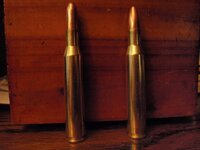- Messages
- 107
- Reactions
- 13
Follow along with the video below to see how to install our site as a web app on your home screen.
Note: This feature may not be available in some browsers.
Now put a hardboiled egg in your mouth. If you use the same amount of force to try to project it out of your mouth, you might blow your eyeballs out of their sockets.
I'd easily challenge this premise, jquirt, by noting that if I load heavier bullets (and am allowed by my action/throat) to the IDENTICAL depth in the case as a lighter bullet, I better darned well decrease my powder charge REGARDLESS. The factor is mass of the projectile.
Seat a 110 grain Spitzer into a .30-06, with a max charge of powder type that might be also applicable to a heavier bullet. Before you seat a 220g Roundnose to the SAME DEPTH in the case, with the same powder, you better reduce the powder charge...
Or, maybe you keep your feathers numbered for just such an occasion.

This is wrong, longer and larger bullets offer greater mass, and a larger bearing surface, they also can include a different angle to the ogive, the increased bearing surface cause much higher friction, this friction and mass results in much higher resistance to movement. You are also forgeting the coatings on powders react to higher pressures, the flame front gets driven into the powder faster as the pressure increases.Reading this thread, the thought is right but the explanation is flawed.
It's not that the bullet is heavier, it's that heavier bullets tend to be larger. Larger bullets means it needs to be seated further into the case (due to max OALs for the cartridge design), thus resulting in lower case volume. This lower case volume means two things:
* less powder that can be put in the case (physically, unless you want to go into compressed loads)
* smaller initial volume in which ignition can occur in
Sure, you could try to use the same amount of powder from a lighter load in a heavier load but when considering those two above factors it causes one thing: significantly higher chamber pressures. Igniting the same amount of powder in a much smaller volume results in much higher pressures that eventually lead to (potentially) catastrophic results. That's why most SAAMI specs also list a maximum chamber pressure.
In layman's terms, and the analogy I've seen used and I've always liked is light a firecracker in your hand. One time, with your hand open, and another time with your hand squeezing it tightly. Which will hurt more? The open hand instance is with a smaller/lighter bullet with a larger chamber volume, and the closed hand is the larger/heavier bullet in a smaller chamber volume. Both have the same amount of powder, but depending on the space provided, the explosive reaction needs to go somewhere. That somewhere is your hand, or in the case of the firearm, the receiver. The receiver can only take so much pressure until it fails.So when reloading specs are done, it's a balancing act (for the sake of this discussion) between the factors of case volume, powder burn rate (which we haven't discussed, but also why you see powder recommendations change depending on the weight/design of the bullet as there are tricks to using a slower burning powder so you don't see that huge pressure spike), and maximum case pressures to insure that there is some safety margin in which the firearm doesn't turn into an IED.